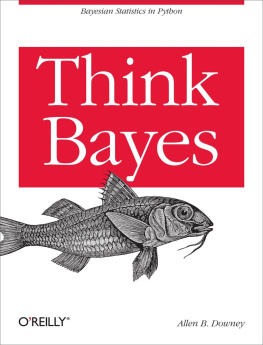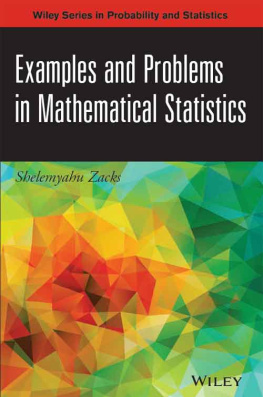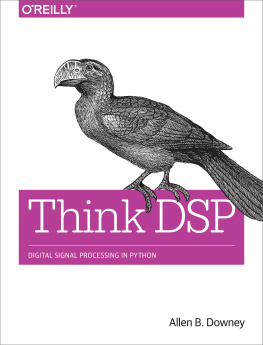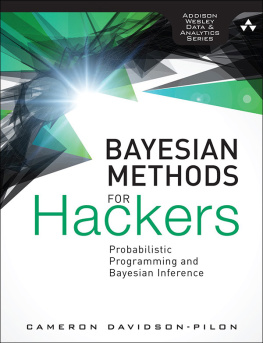Most books on Bayesian statistics use mathematical notation and present ideas in terms of mathematical concepts like calculus. This book uses Python code instead of math, and discrete approximations instead of continuous mathematics. As a result, what would be an integral in a math book becomes a summation, and most operations on probability distributions are simple loops.
I think this presentation is easier to understand, at least for people with programming skills. It is also more general, because when we make modeling decisions, we can choose the most appropriate model without worrying too much about whether the model lends itself to conventional analysis.
Also, it provides a smooth development path from simple examples to real-world problems. is a good example. It starts with a simple example involving dice, one of the staples of basic probability. From there it proceeds in small steps to the locomotive problem, which I borrowed from Mostellers Fifty Challenging Problems in Probability with Solutions , and from there to the German tank problem, a famously successful application of Bayesian methods during World War II.
Modeling and approximation
Most chapters in this book are motivated by a real-world problem, so they involve some degree of modeling. Before we can apply Bayesian methods (or any other analysis), we have to make decisions about which parts of the real-world system to include in the model and which details we can abstract away.
For example, in
In the motivating problem is interpreting SAT scores (the SAT is a standardized test used for college admissions in the United States). I start with a simple model that assumes that all SAT questions are equally difficult, but in fact the designers of the SAT deliberately include some questions that are relatively easy and some that are relatively hard. I present a second model that accounts for this aspect of the design, and show that it doesnt have a big effect on the results after all.
I think it is important to include modeling as an explicit part of problem solving because it reminds us to think about modeling errors (that is, errors due to simplifications and assumptions of the model).
Many of the methods in this book are based on discrete distributions, which makes some people worry about numerical errors. But for real-world problems, numerical errors are almost always smaller than modeling errors.
Furthermore, the discrete approach often allows better modeling decisions, and I would rather have an approximate solution to a good model than an exact solution to a bad model.
On the other hand, continuous methods sometimes yield performance advantagesfor example by replacing a linear- or quadratic-time computation with a constant-time solution.
So I recommend a general process with these steps:
While you are exploring a problem, start with simple models and implement them in code that is clear, readable, and demonstrably correct. Focus your attention on good modeling decisions, not optimization.
Once you have a simple model working, identify the biggest sources of error. You might need to increase the number of values in a discrete approximation, or increase the number of iterations in a Monte Carlo simulation, or add details to the model.
If the performance of your solution is good enough for your application, you might not have to do any optimization. But if you do, there are two approaches to consider. You can review your code and look for optimizations; for example, if you cache previously computed results you might be able to avoid redundant computation. Or you can look for analytic methods that yield computational shortcuts.
One benefit of this process is that Steps 1 and 2 tend to be fast, so you can explore several alternative models before investing heavily in any of them.
Another benefit is that if you get to Step 3, you will be starting with a reference implementation that is likely to be correct, which you can use for regression testing (that is, checking that the optimized code yields the same results, at least approximately).
Working with the code
Many of the examples in this book use classes and functions defined in thinkbayes.py. You can download this module from http://thinkbayes.com/thinkbayes.py.
Most chapters contain references to code you can download from http://thinkbayes.com. Some of those files have dependencies you will also have to download. I suggest you keep all of these files in the same directory so they can import each other without changing the Python search path.
You can download these files one at a time as you need them, or you can download them all at once from http://thinkbayes.com/thinkbayes_code.zip. This file also contains the data files used by some of the programs. When you unzip it, it creates a directory named thinkbayes_code that contains all the code used in this book.
Or, if you are a Git user, you can get all of the files at once by forking and cloning this repository: https://github.com/AllenDowney/ThinkBayes.
One of the modules I use is thinkplot.py, which provides wrappers for some of the functions in pyplot. To use it, you need to install matplotlib. If you dont already have it, check your package manager to see if it is available. Otherwise you can get download instructions from http://matplotlib.org.
Finally, some programs in this book use NumPy and SciPy, which are available from http://numpy.org and http://scipy.org.
Code style
Experienced Python programmers will notice that the code in this book does not comply with PEP 8, which is the most common style guide for Python (http://www.python.org/dev/peps/pep-0008/).
Specifically, PEP 8 calls for lowercase function names with underscores between words, like_this. In this book and the accompanying code, function and method names begin with a capital letter and use camel case, LikeThis.
I broke this rule because I developed some of the code while I was a Visiting Scientist at Google, so I followed the Google style guide, which deviates from PEP 8 in a few places. Once I got used to Google style, I found that I liked it. And at this point, it would be too much trouble to change.
Also on the topic of style, I write Bayess theorem with an s after the apostrophe, which is preferred in some style guides and deprecated in others. I dont have a strong preference. I had to choose one, and this is the one I chose.
And finally one typographical note: throughout the book, I use PMF and CDF for the mathematical concept of a probability mass function or cumulative distribution function, and Pmf and Cdf to refer to the Python objects I use to represent them.
Prerequisites
There are several excellent modules for doing Bayesian statistics in Python, including pymc and OpenBUGS. I chose not to use them for this book because you need a fair amount of background knowledge to get started with these modules, and I want to keep the prerequisites minimal. If you know Python and a little bit about probability, you are ready to start this book.
introduces Suite, a kind of Pmf that provides a framework for doing Bayesian updates. And thats just about all there is to it.
Well, almost. In some of the later chapters, I use analytic distributions including the Gaussian (normal) distribution, the exponential and Poisson distributions, and the beta distribution. In I break out the less-common Dirichlet distribution, but I explain it as I go along. If you are not familiar with these distributions, you can read about them on Wikipedia. You could also read the companion to this book,







